List of largest craters in the Solar System
Following are the largest impact craters on various worlds of the Solar System.
| Body | Crater | Diameter | Diameter of parent body |
Ratio | Images | Notes |
|---|---|---|---|---|---|---|
| Mercury | Caloris | 01.551,550 km (963 mi) | 4,880 km | 32% | 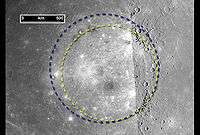 |
|
| Rembrandt | 00.715715 km (444 mi) | 15% |  |
|||
| Venus | Mead | 00.28280 km (170 mi) | 12,100 km | 2% | 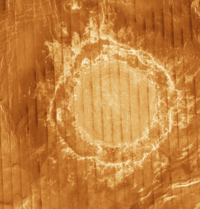 |
|
| Earth | Vredefort | 00.275250–300 km (160–190 mi) | 12,740 km | 2% |  |
|
| Sudbury Basin | 00.250250 km (160 mi) | 2% | 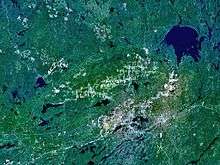 |
|||
| Chicxulub crater | 00.182182 km (113 mi) | 1.4% | 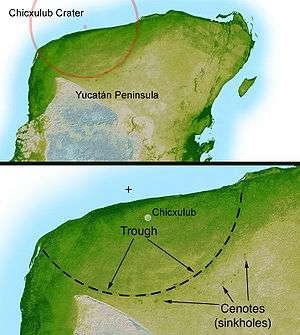 |
Cause of the Cretaceous–Paleogene extinction event | ||
| Moon (moon of Earth) |
Procellarum | 02.53,000 km (2,000 mi) | 3,470 km | 86% |  |
Not confirmed as an impact basin. |
| South Pole–Aitken basin | 02.52,500 km (1,600 mi) | 70% | 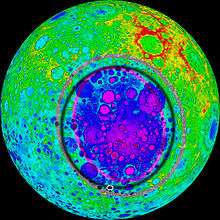 |
|||
| Imbrium | 01.1451,145 km (711 mi) | 33% | 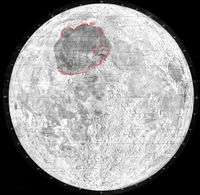 |
|||
| Mars | North Polar Basin | 09.5510,600 × 8,500 km (6,550 × 5,250 mi) | 6,780 km | 125–155% |  |
Not confirmed as an impact basin |
| Utopia | 03.33,300 km (2,100 mi) | 50% |  |
Largest confirmed impact basin on Mars and in the Solar System | ||
| Hellas | 02.32,300 km (1,400 mi) | 34% | 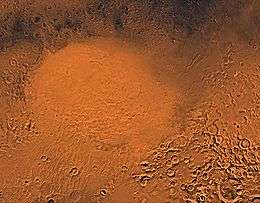 |
Largest visible crater in the Solar System | ||
| Vesta | Rheasilvia | 00.505505 km (310 mi) | 529 km (569 km)[1] | 90%[1] |  |
|
| Veneneia | 00.40395 km (250 mi) | 70%[1] |  |
Partially obscured by Rheasilvia | ||
| Ceres | Kerwan | 00.28284 km (180 mi)[2] | 952 km | 30% | 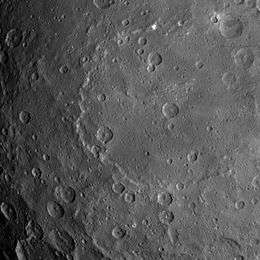 |
Faint shallow crater, below the center of this image. |
| Yalode | 00.27271 km (170 mi)[2] | 28% | 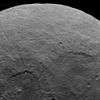 |
|||
| Ganymede (moon of Jupiter) |
Epigeus | 00.343343 km (213 mi) | 5,270 km | 6.5% | 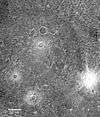 |
|
| Callisto (moon of Jupiter) |
Valhalla | 00.36360 km (224 mi) | 4,820 km | 7.5% |  |
|
| Heimdall | 00.21210 km (130 mi) | 4% | (no good images have been taken) | |||
| Mimas (moon of Saturn) |
Herschel | 00.139139 km (86 mi) | 396 km | 35% | 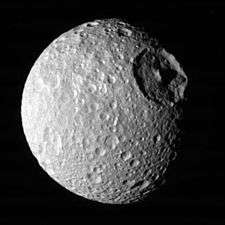 |
|
| Tethys (moon of Saturn) |
Odysseus | 00.445445 km (277 mi) | 1,060 km | 42% | 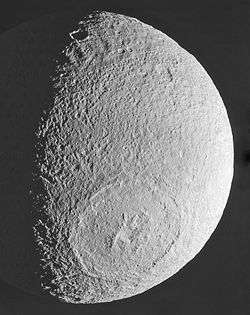 |
|
| Dione (moon of Saturn) |
Evander | 00.350350 km (220 mi)[3] | 1,023 km | 34% |  |
|
| Rhea (moon of Saturn) |
Mamaldi | 00.480480 km (300 mi)[4] | 1,530 km | 31% |  |
|
| Tirawa | 00.36360 km (220 mi) | 24% |  |
|||
| Titan (moon of Saturn) |
Menrva | 00.392392 km (244 mi) | 5,150 km | 7.5% |  |
|
| Iapetus (moon of Saturn) |
Turgis | 00.58580 km (360 mi) | 1,470 km | 40% |  |
|
| Engelier | 00.504504 km (313 mi) | 34% |  |
|||
| Gerin | 00.445445 km (277 mi) | 30% | 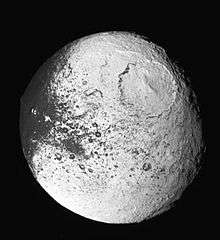 |
Gerin is overlain by Engelier | ||
| Falsaron | 00.424424 km (263 mi) | 29% | 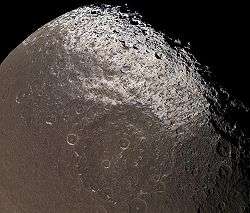 |
|||
| Titania (moon of Uranus) |
Gertrude | 00.326326 km (203 mi) | 1,580 km | 21% |  |
Little of Titania has been imaged, so it may well have larger craters. |
| Pluto | Sputnik basin? | 00.925ca. 1,050×800 km | 2,370 km | 34–44% | 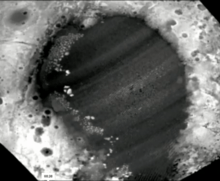 |
|
| unnamed crater | 00.450450 km (280 mi) | 19% |  |
Upper right of image, difficult to see | ||
| Charon (moon of Pluto) |
Mordor | 00.475ca. 475 km (295 mi) | 1,207 km | 40% | 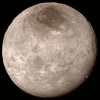 |
Dark region at north pole. Not confirmed as an impact basin. |
| unnamed crater | 00.150ca. 150 km (93 mi) | 12% | 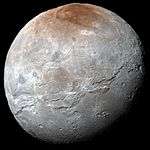 |
Crater at upper right overlapping Mordor Macula |
References
See also
- List of tallest mountains in the Solar System
- List of largest rifts and valleys in the Solar System
- List of largest lakes and seas in the Solar System
This article is issued from Wikipedia - version of the 7/12/2016. The text is available under the Creative Commons Attribution/Share Alike but additional terms may apply for the media files.